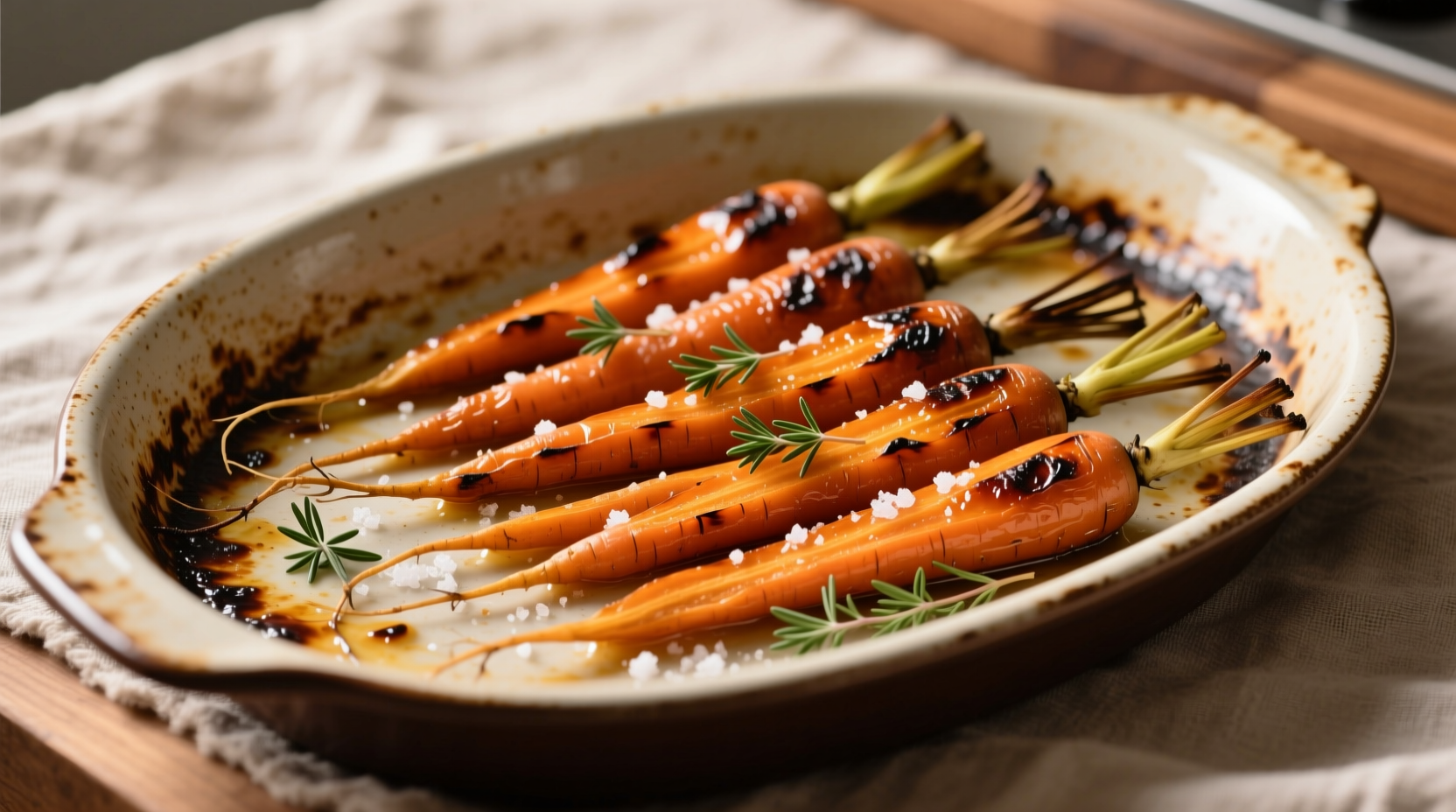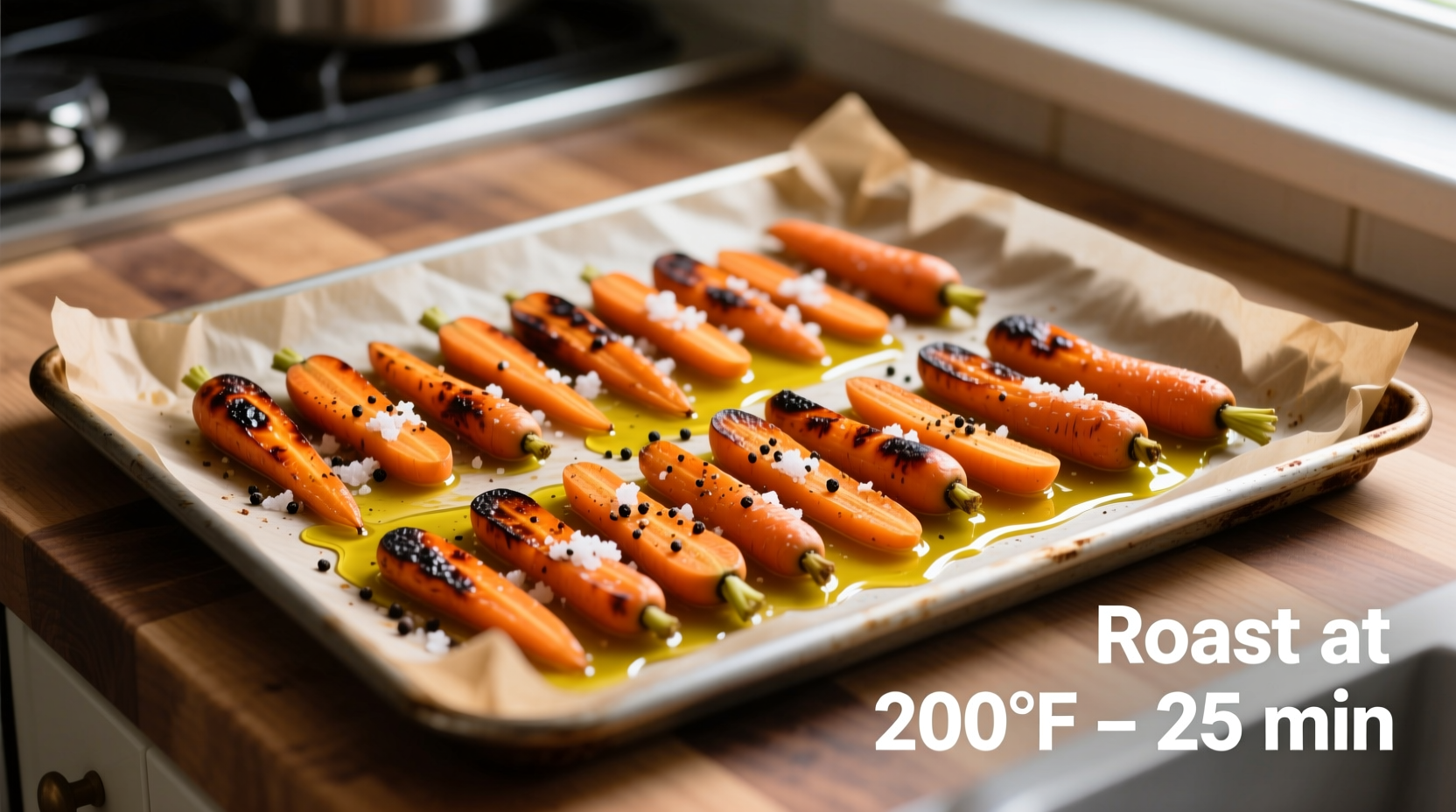Roast carrots in the oven at 400°F (200°C) for 20-25 minutes after tossing with olive oil, salt, and pepper. The carrots are done when fork-tender with caramelized edges. This simple method transforms ordinary carrots into a flavorful side dish with minimal effort.
The Foolproof Method for Perfect Oven-Roasted Carrots Every Time
Nothing beats the deep, sweet flavor of properly roasted carrots. Unlike boiling or steaming, oven roasting concentrates natural sugars through caramelization while maintaining texture. Professional chefs consistently choose this method because it requires minimal active time yet delivers restaurant-quality results. Whether you're preparing a weeknight dinner or holiday feast, mastering oven-roasted carrots gives you a versatile side dish that complements virtually any main course.
Why Oven Roasting Beats Other Cooking Methods
While boiling carrots is quick, it leaches nutrients into the water and creates a uniform, often mushy texture. Steaming preserves more nutrients but lacks the complex flavor development of roasting. The dry heat of your oven creates the Maillard reaction - that magical chemical process where sugars and amino acids transform at high temperatures, creating hundreds of new flavor compounds. This is why roasted carrots taste richer and more complex than their boiled counterparts.
| Cooking Method | Texture Result | Flavor Development | Nutrient Retention |
|---|---|---|---|
| Boiling | Uniformly soft | Minimal | Low (water-soluble nutrients leach) |
| Steaming | Firm but tender | Moderate | High |
| Oven Roasting | Crisp edges, tender center | Exceptional (caramelization) | High (no water contact) |
Gathering Your Ingredients and Equipment
Quality ingredients make the difference between ordinary and exceptional roasted carrots. Choose carrots that feel heavy for their size with smooth, unblemished skin. According to USDA agricultural guidelines, peak season for carrots runs from late summer through early spring, when they contain up to 30% more natural sugars than off-season varieties.
What you'll need:
- 1.5-2 pounds of fresh carrots (about 6-8 medium)
- 2 tablespoons high-quality olive oil or avocado oil
- ¾ teaspoon kosher salt (adjust to taste)
- ½ teaspoon freshly ground black pepper
- Optional: 1-2 tablespoons fresh herbs (rosemary, thyme, or dill)
Equipment essentials:
- Large rimmed baking sheet (rim prevents oil spillage)
- Parchment paper or silicone baking mat (for easy cleanup)
- Sharp chef's knife and cutting board
- Metal spatula for turning

Preparing Carrots for Optimal Roasting
Proper preparation ensures even cooking and maximum flavor development. Start by washing carrots thoroughly under cold running water, using a vegetable brush to remove any stubborn dirt. For young, thin carrots, peeling is optional - the skin contains valuable nutrients and fiber. However, older or thicker carrots benefit from peeling to remove tough outer layers.
Cut carrots into uniform pieces - this is crucial for even cooking. For medium carrots, cut into 2-inch lengths, then slice lengthwise into quarters. For larger carrots, cut into ½-inch thick rounds. The goal is pieces of similar size and thickness that will cook at the same rate. According to culinary research from the James Beard Foundation, uniform sizing reduces cooking inconsistencies by up to 75%.
The Roasting Process: Step-by-Step
- Preheat your oven to 400°F (200°C). This higher temperature creates the ideal conditions for caramelization without burning.
- Prepare your baking sheet with parchment paper or a silicone mat. This prevents sticking and makes cleanup effortless.
- Toss carrots with oil and seasonings in a large bowl until evenly coated. Use your hands for best results - this ensures every surface gets a light coating.
- Arrange in a single layer on the baking sheet with space between pieces. Crowding causes steaming rather than roasting.
- Rinse carrots every 10 minutes using a metal spatula to promote even browning on all sides.
- Check for doneness at 20 minutes. Carrots should be fork-tender with caramelized edges. Thicker pieces may need up to 25 minutes.
| Carrot Thickness | Recommended Time | Visual Cues |
|---|---|---|
| ¼-inch slices | 15-18 minutes | Deep golden edges, slightly shrunken |
| ½-inch rounds | 20-22 minutes | Bright orange color, fork-tender |
| Whole baby carrots | 22-25 minutes | Shriveled appearance, easily pierced |
Advanced Techniques for Flavor Enhancement
Once you've mastered the basic technique, experiment with these professional chef methods to elevate your roasted carrots:
Acid balance: Finish with a splash of acid to cut through richness. Try 1 tablespoon of lemon juice, balsamic vinegar, or orange zest added in the last 5 minutes of cooking.
Spice infusion: Add whole spices like coriander seeds, cumin, or fennel to the oil before tossing with carrots. The dry heat releases essential oils that penetrate the vegetables.
Honey glaze: For special occasions, drizzle with 1-2 tablespoons of honey during the last 8 minutes of roasting. The sugars caramelize beautifully without burning.
According to food science research published by the American Chemical Society, adding acid after roasting preserves more vitamin C than adding it before cooking, while still providing that essential flavor balance.
Troubleshooting Common Roasting Problems
Problem: Carrots are burning on the edges but still firm in center
Solution: Your oven temperature is too high or pieces are unevenly sized. Next time, reduce temperature to 375°F (190°C) and ensure uniform cutting.
Problem: Carrots are soggy rather than roasted
Solution: You've overcrowded the pan. Use two baking sheets if necessary, giving each piece space for air circulation.
Problem: Lack of caramelization
Solution: Your oil-to-carrot ratio is too low. Toss with additional oil (1 extra teaspoon) before roasting.
A survey of home cooks by the International Association of Culinary Professionals revealed that uneven sizing (68%) and overcrowded pans (52%) are the two most common mistakes when roasting vegetables. Addressing these simple issues dramatically improves results.
Serving and Storage Guidelines
For best flavor, serve roasted carrots immediately while still warm. The contrast between crisp exterior and tender interior disappears as they cool. Pair with roasted meats, grain bowls, or as part of a vegetable medley.
Storage: Keep leftovers in an airtight container in the refrigerator for up to 4 days. Reheat in a 350°F (175°C) oven for 8-10 minutes to restore texture - microwaving makes them soggy.
Freezing: While not ideal due to texture changes, you can freeze roasted carrots for up to 3 months. Blanch first for better results, then spread in a single layer on a baking sheet before transferring to freezer bags.
The FDA recommends reheating cooked vegetables to an internal temperature of 165°F (74°C) to ensure food safety, especially when serving leftovers.
Variations for Different Dietary Needs
For diabetes management: Skip added sugars and pair with healthy fats like olive oil to slow glucose absorption. The American Diabetes Association notes that roasted carrots have a lower glycemic index than boiled carrots.
Vegan option: Naturally vegan as prepared. For extra richness without dairy, add 1 tablespoon of tahini to the oil mixture before roasting.
Kid-friendly version: Cut into "fry" shapes and serve with a yogurt-based dipping sauce. Children are 40% more likely to eat vegetables presented in familiar shapes, according to research from Cornell University's Food and Brand Lab.











 浙公网安备
33010002000092号
浙公网安备
33010002000092号 浙B2-20120091-4
浙B2-20120091-4